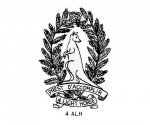EDWARDS, Norman Daly
Norman Edwards was 27 years old when he enlisted on 11 September, 1915. Although he worked for the railways as an engine cleaner and lived in the city, he was placed in the 12th Reinforcements, 4th Light Horse. He was originally from country Victoria, having been born at Mount Egerton. He must have been a striking figure in those days when men were commonly 5' 4" to 5' , being 6' 4" tall. He was first sent to Royal Park, Melbourne for training, placed with the 23rd Depot Battalion, but on 11 October, 1915, was sent to Seymour and after that attached to the 4th Light Horse.
They embarked from Melbourne on 23 November, 1915, on board HMAT Ceramic A40, and went to Egypt, first to Heliopolis, then to Alexandria. Here he joined the 4th Light Horse Regiment, consisting of 23 officers and 497 other ranks. The Fourth Light Horse was a divisional regiment, rather than a cavalry regiment, attached to the 1st Division AIF. Its soldiers had served at Gallipoli, as infantry, rather than mounted troops, and had suffered many casualties. Norman Edwards and the other reinforcements were brought to replace the Gallipoli casualties, bringing the numbers up to make five squadrons. Of these, two were detached to go with AIF Divisions to France, while three remained in Egypt to serve in the Middel East conflict. Norman Edwards was sent to France.
On 20 March, 1916, just before departed from Alexandria, he was transferred from his battalion. It was recognised by then that the Western Front battles would not involved cavalry, although there continued to be divisional mounted troops attached to each division which undertook such tasks as reconnaissance, regulation of troops on marches, security and accompanying risoners of war. Norman Edwards, like other light horseman, transferred to the 1st Australian Cyclists Corps as a volunteer, to be used as a speedy means of communication and transmission of orders. They disembarked in Marseilles on 30 March, 1916, and proceeded by train to the battlefront. Here Edwards was taken on strength with the 1st Cyclists Corps on 12 May.
The cyclists were not really suited to trench warfare. On of their commanders said their tasks were 'directing traffic, unloading railway wagons, harvesting hops for local families and burying the dead.'
Whatever the tsaks he performed, Norman Edwards became ill with influenza on 1 July and was admitted to hospital. Perhaps something was picked up at this point about his health. On recovery, he was transferred to the 2nd Cyclists Corps, but his ill health remained and on 9 September, he was sick again and sent to the No.1 Convalescent Depot at Boulogne. From there, he remained as a member of the 2nd Cyclists Cops, although it was now recognised that he had a disability - tachycardia. There is nothing in his record that says he actually went back to his unit, so perhaps he stayed at Boulogne or at Wimereux, where his heart problem was first noted in his record, while arrangements were made to send him home..
On 6 April, 1917, he was marched out to return to Australia, his next of kin being advised on 28 May, that he would be discharged from service. He returned to Australia on board H.T. Themistocles and was discharged from the AIF in Melbourne on 2 August that year. Once home, he was placed on a service pension, but by 1920, this was reduced.
In 1919, he was living at 1031 Hoddle St., East Melbourne, and again working for the railways as an engine cleaner. In 1931, he was living with Susannah Edwards, perhaps a sister, in Parkville and gave 'railway employee' as his occupation. In 1943, he was listed in the Electoral Roll as living with Susan, engaged in home duties, while he was a labourer. He died at Prahran in 1962, aged 74.
Australian War Memorial Embarkation Roll, photographs
Australian National Archive Service Record
Ancestry.com.au Birth Index, Electoral Roll



